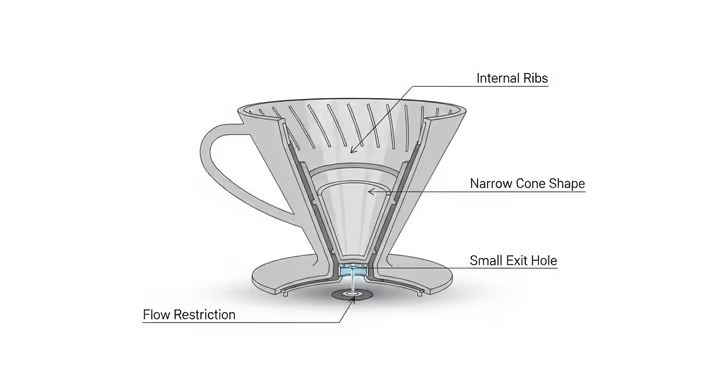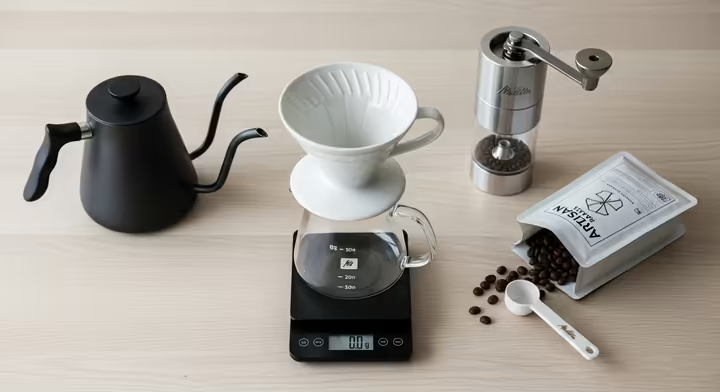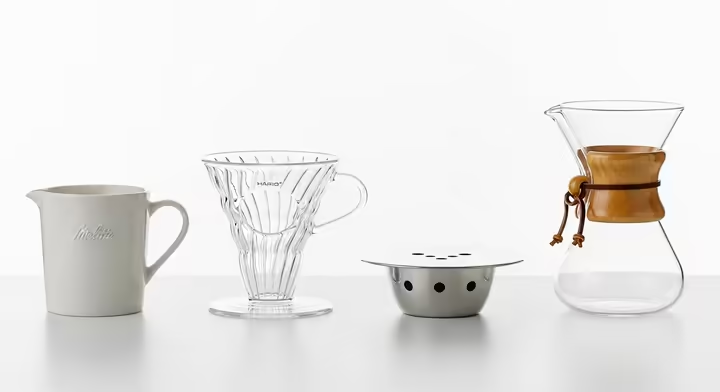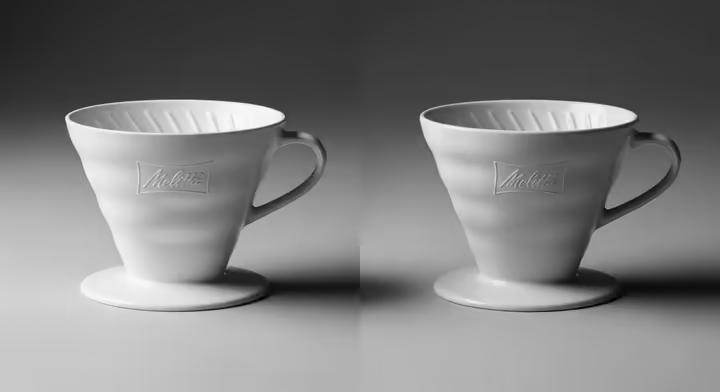The Definitive Guide to the Melitta Pour Over
The Melitta brewer is a coffee classic for a reason. It's simple, forgiving, and makes a great cup without much fuss. This guide covers its history, how it works, what you'll need, and how to brew a perfect cup every time.
A Pour Over History Lesson
The story of modern pour over starts back in 1908, in a quiet German home. A housewife named Amalie Auguste Melitta Bentz was fed up with her coffee. The percolators and cloth filters of the time made a bitter, sludgy mess, and cleaning the cloth filters was a pain. 1 Bentz just wanted a cleaner, better-tasting cup of coffee.
Her solution was wonderfully simple. She took a brass pot, punched a few holes in the bottom, and grabbed a piece of blotting paper from her son's schoolbook. 2 She put the paper in the pot, set it on a cup, added coffee grounds, and poured hot water over it. The result, a clean, grounds-free coffee that tasted much better, was the birth of the paper coffee filter. 1 4

She and her husband, Hugo, patented the "Filter Top Device lined with Filter Paper" in 1908 and started the Melitta company with just 73 Reich pfennigs. 2 This new product introduced the world to paper filtration. Over a century later, the simple, consistent method still makes a clean, flavorful cup of coffee. 5
How It Works
The Melitta brewer looks simple, but its design is smart. Every curve and feature is there to help you brew a great cup of coffee.

The Cone Shape
The Melitta’s cone is narrower than many other brewers, with a flat section at the bottom. 6 This shape forces the coffee grounds into a deep, tapered pile. Because the pile is deeper, water takes longer to travel through it, increasing contact time for a fuller extraction. 8
The Tiny Hole
The most important feature is the single, small exit hole at the base. 6 This hole slows down the water flow, which is why the Melitta is so forgiving. 9 While other brewers (like the Hario V60) need a perfectly controlled pour, the Melitta’s design does the work for you. This built-in control gives a longer, fuller extraction and prevents a sour, under-extracted brew. 10
Those Little Ribs
See those ridges running along the inside walls? They're important. 10 The ribs stop the wet paper filter from sticking to the brewer’s sides. 13 This creates tiny air gaps so water can flow freely, preventing a vacuum that could stall the brew and make your coffee bitter. 13
Getting Your Gear
The Melitta cone is the main event, but you'll need a few other things to make great coffee. The right Melitta paper filters (like a No. 2 or No. 4) are essential for a good fit. 8 The brewer material, whether plastic, ceramic, or porcelain, also affects heat retention and your final brew.

A Good Grinder
A quality burr grinder is non-negotiable for any pour over method. 16 Blade grinders chop beans into a mix of dust and chunks, leading to uneven extraction, where some grounds are bitter (over-extracted) and others are sour (under-extracted). 16 A burr grinder mills beans to a consistent size, so everything extracts evenly for a balanced, tasty cup. 17
A Gooseneck Kettle
A gooseneck kettle gives you precise control over your pour. 15 This control is key for evenly soaking the coffee grounds and avoiding "channeling," where water finds a quick path through the coffee and leaves some grounds dry. 4 It helps you nail the "bloom" and make sure all the coffee gets properly extracted.
A Digital Scale and Timer
A digital scale is your best friend for consistency. 15 Measuring coffee and water by weight instead of volume takes the guesswork out of brewing and lets you hit your perfect ratio every time. 8 A timer helps you track the total brew time, keeping you in that sweet spot for a great cup.
How to Brew With a Melitta
First things first, let's get set up. Heat your water to 195–205°F (90–96°C). 7 Water that's too hot will make your coffee taste harsh. While the water is heating, put a Melitta filter in the cone and rinse it with hot water. 15 This gets rid of any paper taste and preheats the brewer.
Next, grind your beans fresh to a medium-fine texture, kind of like table salt. 7 Add the ground coffee to the filter and give it a gentle tap to create a flat bed. Now for the bloom, pour just enough water (about twice the weight of your coffee) in circles to wet all the grounds. 7 You'll see the coffee bubble and expand as it releases CO2 gas... that means it's fresh. 15 Let it bloom for 30 to 45 seconds. 7

After the bloom, continue pouring in a slow, steady stream. 7 Move in circles from the center out and back again, but try not to pour directly on the filter walls. Your goal is a total brew time between three and four minutes. 12 A good starting ratio is 1 part coffee to 16 parts water (by weight). 24 Once you've added all your water, let it drain, toss the filter, and enjoy your coffee.
Troubleshooting Your Brew
Getting the perfect cup is all about balancing a few things. A finer grind or hotter water will speed up extraction, but too much can make the coffee bitter. 22 25 A coarser grind or cooler water will slow it down, which can lead to a weak or sour cup. 26 How you pour also matters, a slow, steady pour keeps the temperature stable. 30
If your coffee tastes bitter, it’s probably over-extracted. 22 The fix is simple: try a coarser grind, use slightly cooler water, or pour a bit faster to shorten the brew time. 25
If your coffee tastes weak or sour, it's under-extracted. 26 To fix this, use a finer grind, hotter water, or pour more slowly to extend the brew time. 26
Is your brew draining really slowly? You might have too many "fines," or tiny coffee particles, clogging the filter. 14 This usually happens if your grind is too fine or your grinder isn't great. Pouring too aggressively can also cause fines to settle at the bottom and create a clog. 14 Try a coarser grind or a gentler pour. 14
Melitta vs. The World
The Melitta has a unique place among manual coffee brewers. Its design philosophy is quite different from other popular pour over cones, and that changes the coffee in your cup.

Melitta vs. Hario V60
The V60 has a single, huge hole at the bottom and spiral ribs, which lets water flow through very quickly. 4 This gives the brewer total control but requires a very precise pour. A V60 often produces a brighter, lighter-bodied cup that highlights a coffee's subtle flavors. 6 The Melitta, with its slow-flow design, is more forgiving and creates a fuller-bodied, richer cup. 36
Melitta vs. Kalita Wave
The Kalita Wave has a flat bottom with three small holes, which is very different from the Melitta's cone shape. 4 The flat bottom helps saturate the coffee bed evenly, leading to a very consistent extraction and a balanced, sweet cup. 4 The Melitta's deeper, cone-shaped bed tends to produce a fuller-bodied cup.
Melitta vs. Chemex
The biggest difference here is the filter. 4 Chemex uses extra-thick paper filters that remove more of the coffee's oils and fines. 35 This results in an incredibly clean and almost tea-like coffee. 35 Melitta’s thinner filters let more oils and solids through, giving the coffee a heavier body and mouthfeel. 35
| Brewer | Key Design Features | Filter Type | Resulting Cup Profile | Forgiveness Level |
|---|---|---|---|---|
| Melitta | Small, single exit hole; internal ribs; tapered cone | Cone-shaped | Fuller-bodied, rich, balanced, and consistent | High |
| Hario V60 | Large, single exit hole; spiral ribs; conical | Cone-shaped | Brighter, cleaner, acidic, and nuanced | Low |
| Kalita Wave | Three small holes; flat-bottomed bed; unique filter shape | Flat-bottomed | Balanced, sweet, and uniform extraction | Medium |
| Chemex | Thick, bonded filter; hourglass vessel | Cone-shaped | Exceptionally clean, crisp, and tea-like with a light body | High |
Choosing Your Melitta
Melitta brewers come in a few different materials, mainly plastic, ceramic, and porcelain. 39 The material choice impacts both your preference and the brew's thermal stability.
Materials: Plastic vs. Ceramic
The plastic Melitta is cheap, light, and almost impossible to break, making it great for beginners or for travel. 39 Its downside is that plastic doesn't hold heat very well, which can make it harder to keep your water temperature stable, especially for bigger batches. 39

Ceramic and porcelain brewers are much better at retaining heat, which helps maintain a stable temperature for a more consistent extraction. 39 They also look great and don't add any flavor to the coffee. The main drawbacks are that they're fragile and cost more. 40
Sizes: No. 2 vs. No. 4
Melitta brewers and filters come in different sizes, usually No. 2 and No. 4. 8 The No. 2 size is for single servings or small batches (1-6 cups). The larger No. 4 is for bigger batches (8-12 cups). 8 Picking the right size ensures the filter fits correctly for a proper extraction. 8
Common Questions (FAQ)
Here are answers to some of the most common questions about the Melitta pour over.
What's the best Melitta pour over coffee maker?
There's no single "best" one, it depends on what you need. Plastic models are cheap and durable, perfect for beginners. 39 If you want better heat retention for a more stable brew, ceramic and porcelain models are a great choice. 39
What are the basic instructions for beginners?
It's easy! Heat water to 195–205°F, rinse the paper filter in the cone, and then add your medium-fine coffee grounds. 15 Pour a little water to let the coffee "bloom" for 30 seconds. 7 Then, slowly pour the rest of the water in circles until you've reached your desired amount. A good starting ratio is 1g of coffee to 16g of water. 24
What's the ideal grind size for a Melitta?
Aim for a medium-fine grind, like the texture of table salt. 7 This size works perfectly with the Melitta's slow flow rate. Too fine and it will over-extract; too coarse and it will under-extract.
What's the best coffee-to-water ratio?
A great starting point is 1:16 (1 gram of coffee for every 16 grams of water). You can adjust this to your taste, anywhere from 1:14 for a stronger brew to 1:20 for a lighter one. 12 Start at 1:16 and experiment from there.
How is the Melitta different from a V60?
The Melitta has a small hole that restricts flow, making it forgiving and great for beginners. 6 It produces a full-bodied cup. The Hario V60 has a large hole for a fast flow, giving the user total control but requiring more skill. It typically makes a brighter, more nuanced cup. 6
Can I use a cone filter in a flat-bottom brewer?
You can, but you probably shouldn't. A cone-shaped filter won't fit properly in a flat-bottom brewer like the Kalita Wave. 44 This bad fit can cause water to bypass the coffee grounds, leading to a weak and unevenly extracted cup. 44 Always use the filter designed for your brewer.
Why is my Melitta pour over draining so slowly?
A stalled drain is usually caused by too many fine coffee particles clogging the filter. 14 This can happen if your grind is too fine or your grinder is low-quality. Pouring too hard can also push the fines to the bottom. Try a coarser grind or a gentler pour. 14
How do I clean a ceramic Melitta coffee maker?
They're easy to clean. Most ceramic and porcelain models are top-rack dishwasher safe. 39 For daily cleaning, a quick rinse with hot water is usually enough. 25 For a deeper clean, use a little mild soap or a coffee equipment cleaner to remove any built-up coffee oils.
Final Thoughts
The Melitta brewer is a classic for a reason. It both created a new brewing method and laid the foundation for the modern coffee world. It's forgiving, consistent, and proves that sometimes, the simplest solutions really are the best.
Works cited
- From yuck to yum: A brief history of pour over coffee, featuring the inimitable Melitta Bentz, https://eightouncecoffee.com/blogs/news/from-yuck-to-yum-a-brief-history-of-pour-over-coffee-featuring-the-inimitable-melitta-bentz
- Amalie Auguste Melitta Bentz | PDF | Coffee | Drink - Scribd, https://www.scribd.com/document/524722555/Melitta-Bentz
- Our Passion through the Years - Melitta, https://www.melitta.com/en/Our-Passion-through-the-Years-628.html
- Melitta, Chemex, & More: A History of Pour Over Coffee - Perfect Daily Grind, https://perfectdailygrind.com/2019/01/melitta-chemex-more-a-history-of-pour-over-coffee/
- Melitta® Journey through Time, https://www.melitta.com/en/Melitta-Journey-through-Time-541.html
- Hario V60 vs. Melitta filter cone - Daily Coffee, https://www.dailycoffee.co/hario-v60-vs-melitta-filter-cone/
- How to Make Melitta Pour Over Coffee, https://primeroastcoffee.com/about-prime-roast-coffee/emilys-coffee-brewing-guides/how-to-make-melitta-pour-over-coffee/
- Coffee Filter 4 vs 2: Size, Shape & Brew Guide, https://coffeemachinetools.com/coffee-filter-4-vs-2-size-shape-brew-guide/
- Brewing Methods - Melitta, https://www.melitta.com/en/Brewing-Methods-548.html
- Melitta® Series 1-Cup Coffee Pour-Over - Matte Black Site, https://shoponline.melitta.com/products/signature-series-1-cup-pour-over-coffeemaker-porcelain-matte-black
- Flow Control: The New Era In Coffee - Whole Latte Love, https://www.wholelattelove.com/blogs/articles/flow-control
- Guide To Pour-Over Coffee, https://counterculturecoffee.com/blogs/counter-culture-coffee/guide-to-pour-over-coffee
- What do ribs on coffee drippers do? : r/Coffee - Reddit, https://www.reddit.com/r/Coffee/comments/hu3drx/what_do_ribs_on_coffee_drippers_do/
- 5 Reasons Your Pour Over is Stalling | The Coffee Chronicler, https://coffeechronicler.com/stalling-choking-pour-over/
- Easy Melitta Pour Over Instructions (With Pictures) - Corner Coffee Store, https://cornercoffeestore.com/melitta-pour-over-instructions/
- Why Your Grinder is the Most Important Piece of Coffee Gear, https://www.lannacoffeeco.com/blogs/news/why-your-grinder-is-the-most-important-piece-of-coffee-gear
- Why Do I Need a Burr Coffee Grinder? | Fratello Coffee, https://www.fratellocoffee.com/blogs/blog/benefits-of-burr-grinder
- 6 Reasons You Need A Gooseneck Kettle For Pour Over Coffee ..., https://roguewavecoffee.ca/blogs/education-journal/6-reasons-you-need-a-gooseneck-kettle-for-pour-over-coffee
- Tips to a Better Cup - Melitta, https://www.melitta.com/en/Tips-to-a-Better-Cup-547.html
- Brewing with the Melitta - Medium Grind w/ Ratio of 1:17, https://voltagecoffee.com/melitta/
- How to Brew Pour-Over Coffee | Blue Bottle Coffee, https://bluebottlecoffee.com/us/eng/brew-guides/pour-over
- Why is My Pour Over Coffee Bitter: Exploring Causes & Fixes, https://majestycoffee.com/blogs/posts/why-is-my-pour-over-coffee-bitter
- Melitta® 1-Cup Pour-Over™ Coffee Brew Cone - Black | Official, https://shoponline.melitta.com/products/1-cup-pour-over-coffee-brew-cone-black
- Optimal Melitta Technique?? : r/pourover - Reddit, https://www.reddit.com/r/pourover/comments/kxoolu/optimal_melitta_technique/
- Why Does Your Coffee Taste Bitter & How to Fix It, https://www.redber.co.uk/blogs/blog/why-does-your-coffee-taste-bitter-how-to-fix-it
- How to troubleshoot a weak and sour coffee, and a bitter coffee ..., https://roguewavecoffee.ca/blogs/education-journal/how-to-troubleshoot-a-weak-and-sour-coffee-and-a-bitter-coffee
- Experts, what can you tell about my coffee? : r/superautomatic - Reddit, https://www.reddit.com/r/superautomatic/comments/192bbo5/experts_what_can_you_tell_about_my_coffee/
- Why Your Coffee Tastes Bitter & 6 Ways To Fix It, https://club.atlascoffeeclub.com/bitter-coffee-and-6-fixes/
- Coffee Brewing Help: Why is my coffee watery?, https://onegreatcoffee.com/blogs/latest-news/coffee-brewing-help-why-is-my-coffee-watery
- Your Go-To Pour Over Guide - Roast House Coffee, https://roasthousecoffee.com/blogs/news/your-go-to-pour-over-guide
- Pour-over method: Continuous vs Pulsed vs Dump-And-Run? : r/Coffee - Reddit, https://www.reddit.com/r/Coffee/comments/718bv7/pourover_method_continuous_vs_pulsed_vs_dumpandrun/
- 5 reasons your pour over is stalling (and how to FIX it) - YouTube, https://www.youtube.com/watch?v=mnU56owzt10
- *TIPS* Last remnants of the pourover draining very slowly : r/Coffee - Reddit, https://www.reddit.com/r/Coffee/comments/41jfvg/tips_last_remnants_of_the_pourover_draining_very/
- I TESTED AND COMPARED THE MELITTA AND THE V60: WHICH IS BETTER? - YouTube, https://www.youtube.com/watch?v=Tx-ZkvaC65M
- The Facts About Filters | Stumptown Coffee Roasters, https://www.stumptowncoffee.com/blogs/news/the-facts-about-filters
- Melitta vs Hario V60 - YouTube, https://www.youtube.com/watch?v=W_B4saBirNk
- What is the Best Style of Pour Over? An In-Depth Look at Top Pour Over Methods, https://whitehorsecoffee.com.au/blogs/blog/what-is-the-best-style-of-pour-over-an-in-depth-look-at-top-pour-over-methods
- Chemex vs. Melitta : r/Coffee - Reddit, https://www.reddit.com/r/Coffee/comments/1ndqxs/chemex_vs_melitta/
- The 6 Best Pour-Over Coffee Makers, Tested & Reviewed, https://www.thespruceeats.com/best-pour-over-coffee-makers-4586281
- Pour Over Coffee Dripper Review - Plastic vs Ceramic - TotallyUniqueLife.com, https://totallyuniquelife.com/pour-over-coffee-dripper-review-plastic-vs-ceramic/
- Melitta Pour Over Systems - armeno coffee roasters, https://armeno.com/products/melitta-pour-over
- Difference between #2 and #4 coffee filters? - Coffee Filter Sizes Explained - YouTube, https://www.youtube.com/watch?v=FY0Laht0BX4
- coffeehero.com.au, https://coffeehero.com.au/blogs/news/how-to-brew-with-a-melitta-coffee-machine#:~:text=To%20brew%20with%20a%20Melitta%20pour%2Dover%2C%20you'll,a%20ratio%20of%201%3A17.&text=The%20ideal%20water%20temperature%20should%20be%2090%20to%2096%20degrees%20Celsius.
- Melitta filters vs. Kalitta wave filters : r/Coffee - Reddit, https://www.reddit.com/r/Coffee/comments/3p0kgc/melitta_filters_vs_kalitta_wave_filters/